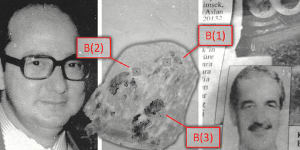The naked body of Ernest Head,44,was found in his apartment on Grosvenor Crescent,Summer Hill,on June 22,1976. He was last seen alive on June 17.

From left:Ernest Head,the palm prints found at the scene of the crime,and suspect Engin Simsek.Exhibits tendered in LGBTIQ hate crimes inquiry
Kathleen Heath,one of a team of counsel assisting the state’s special commission of inquiry into LGBTIQ hate crimes,told a hearing in Sydney on Tuesday that Head was “the victim of a frenzied knife attack,suffering 35 stab wounds to the body and face”.
There was no sign of forced entry to his apartment and there was evidence that Head,a gay man,had engaged in intercourse shortly before his death.
“Mr Head’s case is one in which the investigations of this inquiry have resulted in a substantial development,” Heath said.
“The available evidence now indicates the involvement of a known person,Mr Engin Simsek,in the death of Mr Head.”
The inquiry has identified a number of leads in unsolved homicides,. It has also exposed major shortcomings in NSW Police storage and retention of exhibits.
In April this year,the inquiry requested an examination of three bloody palm prints found above Head’s body. One print,dubbed B1,was “matched for the first time to a known person,Mr Engin Simsek”,Heath said.
Counsel assisting said police should not be criticised for failing to find the match during earlier case reviews because significant upgrades to a national database in 2015 post-dated that work.
The inquiry heard Simsek’s prints had been taken by police in 1980,when the practice was to capture only the upper portion of the palm. Prints dubbed B2 and B3 captured the lower portion of a palm,and it could not be ruled out that they were from the same person.
Cigarette butts,located in 2005,were also sent for testing by the inquiry and a “weak partial DNA profile” from an unknown person was obtained from one. There was no reference DNA profile available for Simsek,Heath said.
Heath said that it appeared a series of other exhibits from the crime scene were either lost or destroyed between 1976 and 2005.
“It is unknown whether Mr Simsek was gay,bisexual,or had sex with men,” Heath said. “The inquiry has not found any evidence of a prior relationship between Mr Simsek and Mr Head.”
The inquiry had confirmed Simsek died by suicide in Turkey on May 6,1999.
“Ultimately,while the bloody palm print is consistent with Mr Simsek being responsible for Mr Head’s death,the role that Mr Simsek played … remains unknown,” Heath said.
“In view of Mr Simsek’s death,it is not now possible for him to answer any allegation that he was responsible for or otherwise involved in Mr Head’s death.”
Heath said the original police investigation was thorough,and “the principal concern raised in Mr Head’s case,as in many other cases examined by this inquiry,relates to the retention,preservation,storage and tracking of exhibits”.
Significant forensic testing opportunities had been lost because the majority of exhibits could not be found,Heath said.
DNA testing was not foreseeable in 1976,Heath said,but physical evidence was “nonetheless important” at that time,and it should have been obvious they should have been retained.
She said the 2015 upgrade to the fingerprint database should also have served as a prompt to NSW Police to re-submit any unidentified prints for re-examination.
Start the day with a summary of the day’s most important and interesting stories,analysis and insights..